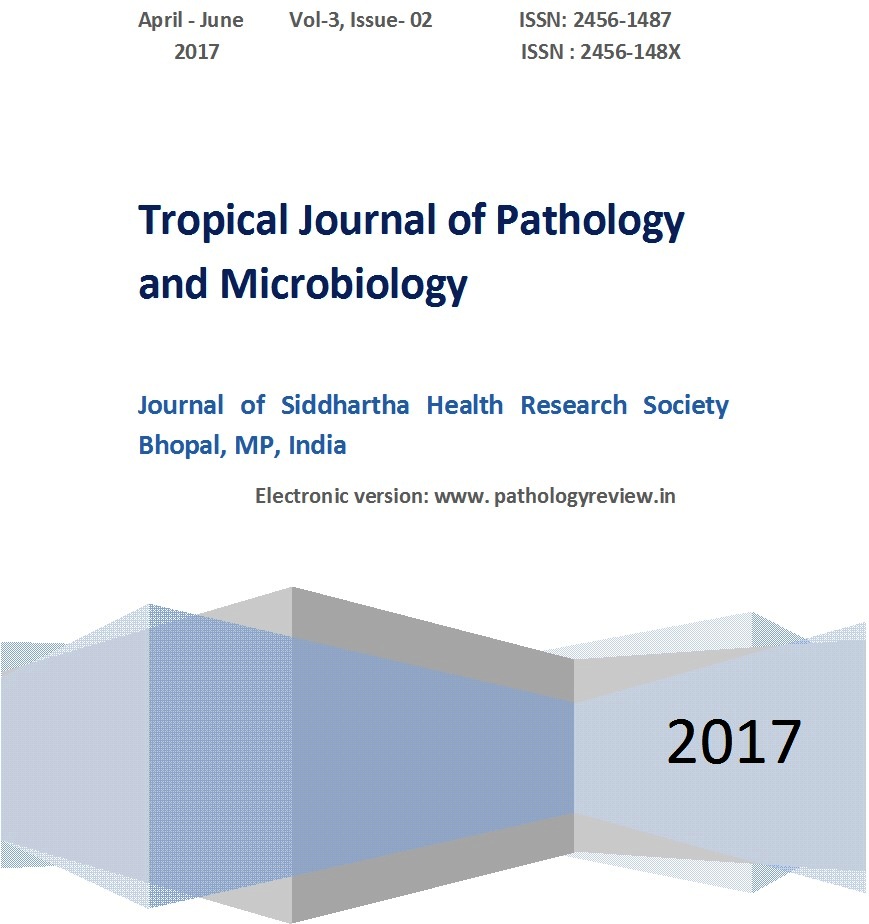Frequency and antibiogram pattern of gram positive cocci in catheter related blood stream infections (CRBSI) in a tertiary care hospital, Tamilnadu
Abstract
Introduction: Blood stream infection associated with catheter is life threatening. Various bacterial agents are responsible for this and Coagulase Negative Staphylococci (CoNS) is now becoming one of the major agent in Catheter Related Blood Stream infection (CRBSI). Objectives: To know the bacterial isolates and the frequency of the CoNS & its antibiotic resistance patterns of in Catheter Related Blood Stream infection (CRBSI).
Methods: Catheter tips (5 cm tip) were collected and 5 ml of peripheral blood sample was collected with proper aseptic precautions. Catheter tips were processed using Maki DG et al procedure. Blood was inoculated into the BACTEC blood culture bottle (BacT/ALERT 3D automated blood culture system –BioMerieux). All the gram positive bacteria were further processed for standard biochemical tests. All these isolates were subjected to antibiotic susceptibility testing (Hi-Media discs) by Kirby Bauer disc diffusion test according to CLSI guidelines.
Results: Among the total 158 isolates, 55 (34.8%) were gram positive cocci. Coagulase Negative Staphylococci (CoNS), were the predominant isolate in this study. Highest resistance was observed with ampicillin, penicillin, amoxyclav, erythromycin and tetracycline. All the gram positive isolates were 100% sensitive to Vancomycin and Linezolid.
Conclusion: Among the total 158 isolates, 55 (34.8%) were gram positive cocci. Coagulase negative staphylococci (CONS) which account 18.98%, followed by 8.86%, Staphylococcus aureus, 5.06% Enterococci and 1.89% were Micrococci. All our isolates were sensitive to Vancomycin and linezolid.
Downloads
References
2. Kaur M, Gupta V, Gombar S, Chander J, Sahoo T. Incidence, risk factors, microbiology of venous catheter associated bloodstream infections--a prospective study from a tertiary care hospital. Indian J Med Microbiol. 2015 Apr-Jun;33(2):248-54. doi: 10.4103/0255-0857.153572. [PubMed]
3. Vincent JL, Bihari DJ, Suter PM, Bruining HA, White J, Nicolas-Chanoin MH, Wolff M, Spencer RC, Hemmer M. The prevalence of nosocomial infection in intensive care units in Europe. Results of the European Prevalence of Infection in Intensive Care (EPIC) Study. EPIC International Advisory Committee. JAMA. 1995 Aug 23-30;274(8):639-44.
4. Eggimann P, Pittet D. Overview of catheter related blood stream infections with special emphasis on prevention based on educational programs. Clin microbial infect 2002; 8:295-309.
5. Akingbade OA, Ojo DA, Okerentuba PO, Adejuwon AO, Okonko I O. Antibiotic resistant profile of bacteria isolated from septicaemia cases in a tertiary health care in Abeokuta, Nigeria. Nature and science 2013:11(2)
6. Qureshi M, Aziz F. Prevalence of microbial isolates in blood culture and their antimicrobial susceptibility profile. Biomedica 2011; 27: 136-39.
7. Vanitha Rani N, Kannan Gopal, Venkata Narendra M, Viswakanth D, V R D Nagesh, YohithaM, Venkatasunil M, ThennarasuPalani. A retrospective study on blood stream infections and antibiotic susceptibility patterns in a tertiary care teaching hospital. International journal of pharmacy and pharmaceutical sciences. Vol 4, 1:2012.
8. Bailey &Scottt’s Diagnostic microbiology.13th edition, Elsevier publications.
9. Maki DG, Weise CE, Sarafin HW. A semiquantitative culture method for identifying intravenous-catheter-related infection. N Engl J Med. 1977 Jun 9;296(23):1305-9. [PubMed]
10. Clinical and Laboratory Standards Institute. Performance standards for antimicrobial susceptibility testing; CLSI, 2014. [PubMed]
11. S.B. Mishra, R. Misra, A. Azim, A.K. Baronia, K.N. Prasad, T.N. Dhole, M. Gurjar, R.K. Singh, B. Poddar.Incidence, risk factors and associated mortality of central line-associated bloodstream infections at an intensive care unit in northern India. Int J Qual Health Care. 2016:29(1). Doi:10.1093/intqhc/mzw144.
12. Ashwini Saminder Waghmare, M.HimaBindu, C. Mallikarjuna Reddy. Bacterial isolates and antibiotic susceptibility pattern in blood stream infections suspected patients attending a teaching hospital in Telungana, India. Int.J.Curr.Microbiol.App.Sci (2015) 4(7): 741-748.
13. Martins M.M, Chukwuemeka E.A, Anne E.A, Joseph U.O, Simon.E A. Bacterial isolates from blood cultures of children with suspected septicaemia in calbar Nigeria. BMC Infectious Diseases: 2005: 5:110.
14. Mulat Dagnew, GizachewYismaw ,Mucheye Gizachew , Alemayehu Gadisa , Tigist Abebe , Tinebeb Tadesse, Agersew Alemu and Biniam Mathewos. Bacterial profile and antimicrobial susceptibility pattern in septicemia suspected patients attending Gondar University Hospital, Northwest Ethiopia, January 2013:6 (283):1-7.
15. Richard S. Johannes, Marlborough, Massachusetts. Epidemiology of early-onset bloodstream infection and implications for treatment. American journal of infection control December 2008:Volume 36, Issue 10, Pages S171- e13- e17.doi:http://dx.doi.org/10.1016/j.ajic.2008.10.003.
16. K Chopdekar, C Chande, S Chavan, P Veer, V Wabale, K Vishwakarma, A Joshi. Central venous catheter-related blood stream infection rate in critical care units in a tertiary care, teaching hospital in Mumbai. Year : 2011 | Volume : 29 | Issue : 2 | Page : 169-171.
17. Surekha.Y.Asangi, Mariraj. J, Sathyanarayan.M.S, Naghabhushan, Rashmi. Speciation of clinically significant Coagulase Negative Staphylococci and their antibiotic resistant patterns in a tertiary care hospital. Int J Biol Med Res: 2011:2(3):735-739.
18. Shubhra Singh, Gopa Banerjee et al. Prevalence of MecA gene positive Coagulase Negative Staphylococci in NICU of tertiary care hospital. Biomedical Research.2009:20(2); 94-98.
19. Meenakshi Kante, Muni Lakshmi P, Sreenivasulu Reddy P. Bacterial profile of blood stream infections and their antibiograms. Int J Res Med Sci. 2015; 3(3): 698-704.
20. I. Roy, A. Jain, M. Kumar, and S. K. Agarwal. Bacteriology of neonatal septicemia in a tertiary care hospital of Northern India. Indian Journal of Medical Microbiology, vol. 20, pp. 156–159, 2002.
21. Jyoti Pal, Dakshina Bisht. Characterization and Risk Factors of Candida Species in Nosocomial Blood Stream Infections. Santosh University Journal of Health Sciences 2015; 1(2):57-59.
22. Parameswaran R, Sherchan JB, Varma D M, Mukhopadhyay C, Vidyasagar S. Intravascular catheter-related infections in an Indian tertiary care hospital. J Infect Dev Ctries. 2011 Jul 4;5(6):452-8.
23. Sharma PP, Halder D, Dutta AK, Dutta R, Bhatnagar S, Bali A, Kumari S. Bacteriological profile of neonatal septicemia. Indian Pediatr. 1987 Nov;24(11):1011-7.



 OAI - Open Archives Initiative
OAI - Open Archives Initiative


